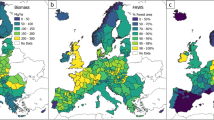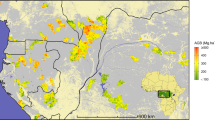Abstract
One of the most important databases needed for estimating emissions of carbon dioxide resulting from changes in the cover, use, and management of tropical forests is the total quantity of biomass per unit area, referred to as biomass density. Forest inventories have been shown to be valuable sources of data for estimating biomass density, but inventories for the tropics are few in number and their quality is poor. This lack of reliable data has been overcome by use of a promising approach that produces geographically referenced estimates by modeling in a geographic information system (GIS). This approach has been used to produce geographically referenced, spatial distributions of potential and actual (circa 1980) aboveground biomass density of all forests types in tropical Africa. Potential and actual biomass density estimates ranged from 33 to 412 Mg ha−1 (106g ha−1) and 20 to 299 Mg ha−1, respectively, for very dry lowland to moist lowland forests and from 78 to 197 Mg ha−1 and 37 to 105 Mg ha−1, respectively, for montane-seasonal to montane-moist forests. Of the 37 countries included in this study, more than half (51%) contained forests that had less than 60% of their potential biomass. Actual biomass density for forest vegetation was lowest in Botswana, Niger, Somalia, and Zimbabwe (about 10 to 15 Mg ha−1). Highest estimates for actual biomass density were found in Congo, Equatorial Guinea, Gabon, and Liberia (305 to 344 Mg ha−1). Results from this research effort can contribute to reducing uncertainty in the inventory of country-level emission by providing consistent estimates of biomass density at subnational scales that can be used with other similarly scaled databases on change in land cover and use.
Similar content being viewed by others
References
Brown, S. and Iverson, L. R.: 1992, Biomass estimates for tropical forests, World Resource Review 4, 366–384.
Brown, S. and Lugo, A. E.: 1982, Storage and production of organic matter in tropical forests and their role in the global carbon cycle, Biotropica 14, 161–187.
Brown, S. and Lugo, A. E.: 1992, Aboveground biomass estimates for tropical moist forests of the Brazilian Amazon, Interciencia 17, 8–18.
Brown, S., Gillespie, A. J. R., and Lugo, A. E.: 1989, Biomass estimation methods for tropical forests with application to forest inventory data, Forest Science 35, 881–902.
Brown, S., Gillespie, A. J. R. and Lugo, A. E.: 1991, Biomass of tropical forests of South and Southeast Asia, Canadian Journal of Forest Research 21, 111–117.
Brown, S., Iverson, L. R., Prasad, A., and Liu, S.: 1993, Geographical distributions of carbon in biomass and soils of tropical Asian forests, Geocarto International 4, 45–59.
Clement, J. and Nouvellet, Y.: 1978, Inventaire Forestier dans la Zone d'Edenzork, Republique du Gabon, Societe Gabonaise de Cellulose, Centre Technique Forestier Tropical, Nogent-sur-Marne, France.
Development and Resources Corporation: 1967, Forestry Resources of the Southwest Region, a report to the government of the Republic of Ivory Coast.
Dixon, R. K., Brown, S., Houghton, R. A., Solomon, A., and Wisnieski, J.: 1994, Carbon pools and flux of global forest ecosystems, Science 263, 185–190.
Flint, E. P. and Richards, J. F.: 1994, Trends in carbon content of vegetation in South and Southeast Asia associated with changes in land use, in Dale, V. (ed.), Effects of Land Use Change on Atmospheric CO Concentrations: Southeast Asia as a Case Study, New York: Springer-Verlag, 201–300.
Food and Agriculture Organization, (FAO): 1971–81, Soils Map of the World 1:5,000,000, FAO-UNESCO.
FAO: 1989, Studies on the Volume and Yield of Tropical Forest Stands I. Dry Forest Formations, FAO Forestry Paper 51/1.
FAO: 1993, Forest Resources Assessment 1990 Tropical Countries, FAO Forestry Paper 112.
Goldammer, J. G.: 1993, Historical biogeography of fire: tropical and subtropical, in Crutzen, P. J. and Goldammer, J. G. (eds.), Fire in the Environment: the Ecological, Atmospheric, and Climatic Importance of Vegetation Fires, Chichester, U.K.: John Wiley and Sons, 297–314.
Iverson, L. R., Brown, S., Prasad, A., Mitasova, H., Gillespie, A. J. R., and Lugo, A. E.: 1994, Use of GIS for estimating potential and actual biomass for continental South and Southeast Asia, in Dale, V. (ed.), Effects of Land Use Change on Atmospheric CO 2 Concentrations: Southeast Asia as a Case Study, Springer-Verlag, New York: ch. 3.
Lavenu, F.: 1987, Vegetation Map of Africa Scale 1:1,5000,000, Institute de la Carte Internationale de la Vegetation, Universite Paul Sabatier, Toulouse, France, Distributed by FAO Forest Resources Assessment 1990 Project, Rome, Italy.
Pierlot, R.: 1966, Structure et composition de forets denses d'Afrique, especialement celles du Kivu, Academie Royale des Sciences d'Outre-mer, Classes des Sciences Naturelles et Medicales, N.S.-XVI-4, Bruxelles, Belgium.
Republique de Cote D'Ivoire, Ministere des Eaux et Foret: 1975, Analyse et Commentaires des Resultats de l'Inventaire Forestier de la Region Nord-Ouest. Resultats de la Region du Nord-Ouest, Inventaire Forestier National, Direction des Inventaire et Amenagement (SODEFOR), Abidjan.
Sharma, M. K.: 1986, Ecofloristic Zones of Africa, Institute de la Carte Internationale de la Vegetation, Universite Paul Sabatier, Toulouse, France, Distributed by FAO Forest Resources Assessment 1990 Project, Rome, Italy.
United Nations Development Program: 1972, Forestry Inventory of the Gola Forest Reserves, Report to the Government of Sierra Leone, FAO.
Author information
Authors and Affiliations
Rights and permissions
About this article
Cite this article
Brown, S., Gaston, G. Use of forest inventories and geographic information systems to estimate biomass density of tropical forests: Application to tropical Africa. Environ Monit Assess 38, 157–168 (1995). https://doi.org/10.1007/BF00546760
Issue Date:
DOI: https://doi.org/10.1007/BF00546760




